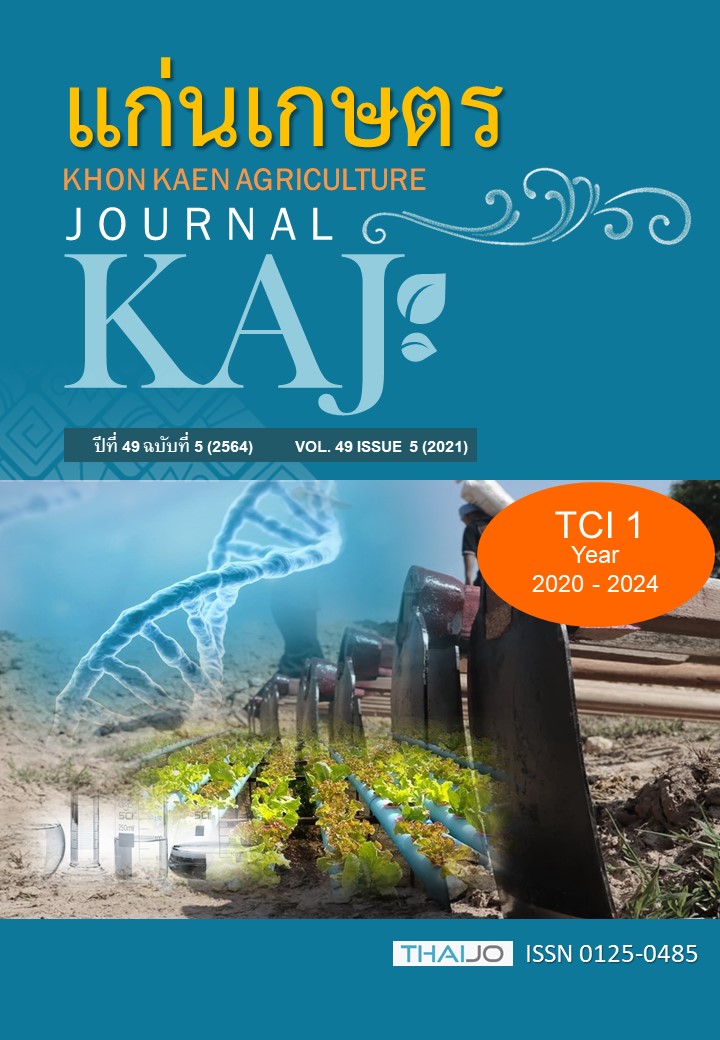Candidatus phytoplasma solani สาเหตุโรคของมะละกอที่เกิดจากไฟโตพลาสมาในประเทศไทย
Main Article Content
บทคัดย่อ
โรคที่เกิดจากไฟโตพลาสมาของมะละกอเป็นโรคที่พบการแพร่ระบาดมากในหลายประเทศนานนับทศวรรษ ก่อให้เกิดอาการเหลือง ไหม้จากปลายยอด และด่าง แต่ยังไม่เคยมีรายงานในประเทศไทย รายงานนี้เป็นการพบเชื้อ Candidatus Phytoplasma solani สาเหตุโรคของมะละกอในประเทศไทยเป็นครั้งแรก ทำการตรวจเชื้อไฟโตพลาสมาในมะละกอที่แสดงอาการคล้ายโรคที่เกิดจากไฟโตพลาสมาด้วยเทคนิค Nested Polymerase Chain Reaction (Nested PCR) โดยใช้ไพรเมอร์ P1/P7 และ R16F2n/R16R2 ในการเพิ่มปริมาณยีน 16S rRNA พบเชื้อในตัวอย่างที่แสดงอาการ 6 ลักษณะ ได้แก่ 1) อาการใบเหลือง แผลไหม้จากขอบใบเข้าหาเส้นใบ 2) อาการคล้าย bunchy top 3) อาการแตกยอดข้างลำต้น ใบหนา ย่น ผิดรูป และเหลือง 4) อาการเส้นใบเขียว 5) อาการใบยอดเหลือง และ 6) อาการใบย่นและด่างเขียว เมื่อตรวจดูภายใต้กล้องจุลทรรศน์อิเล็กตรอนแบบส่องผ่าน พบเซลล์ไฟโตพลาสมาภายในเซลล์ท่ออาหารของตัวอย่างมะละกอที่ตรวจพบเชื้อด้วย Nested PCR ทำการตรวจลำดับนิวคลีโอไทด์ยีน 16S rRNA และส่งเก็บข้อมูลไปยัง GenBank, NCBI จำนวน 6 ไอโซเลท ได้รับหมายเลข accession ดังนี้ MT548611, MT548613, MT548614, MW464326, MW464330 และ MW533147 เมื่อทำการวิเคราะห์ Phylogenetic tree เปรียบเทียบกับลำดับนิวคลีโอไทด์เชื้อไฟโตพลาสมาสาเหตุโรคมะละกอในต่างประเทศ จำนวน 17 ตัวอย่าง จากฐานข้อมูล พบว่า MT548614, MW464326 และ MW464330 จัดอยู่ในกลุ่มย่อยเดียวกับเชื้อ Ca. Phytoplasma solani สาเหตุโรคในมะละกอของไต้หวัน และจากการวิเคราะห์ pairwise distance พบว่ามีค่าความเหมือน 100% ส่วน MT548611, MT548613 และ MW533147 จัดได้เป็นกลุ่มย่อยอื่น ส่วนการเปรียบเทียบความเหมือนในระหว่างเชื้อทั้ง 6 ไอโซเลท พบว่ามีค่า 99.86-100%
Article Details

อนุญาตภายใต้เงื่อนไข Creative Commons Attribution-NonCommercial-NoDerivatives 4.0 International License.
เอกสารอ้างอิง
สุภาพร กลิ่นคง. 2552. ไฟโตพลาสมาสาเหตุโรคพืช. โรงพิมพ์บริษัทศูนย์การพิมพ์เพชรรุ่ง จำกัด, นนทบุรี.
Abeysinghe, S, W.G.S.M. Kumari, I.M.M. Arachchi, and M. Dickinson. 2014. First report of the molecular identification of a phytoplasma associated with dieback disease of papaya in Sri Lanka. New Disease Reports. 29: 13.
Arocha, Y., B. Pinol, K. Acosta, R. Almeida, J. Devonshire, A. Van de Meene, E. Boa, and J. Lucas. 2009. Detection of phytoplasma and potyvirus pathogens in papaya (Carica papaya L.) affected with “Bunchy Top Symptom” (BTS) in eastern Cuba. Journal of Plant Protection Research. 28: 640-646.
Arocha, Y., M. Lopez, B. Pinol, M. Fernandez, B. Picornell, R. Almeida, I. Palenzuela, M. R. Wilson, and P. Jones. 2005. 'Candidatus Phytoplasma graminis' and 'Candidatus Phytoplasma caricae', two novel phytoplasmas associated with diseases of sugarcane, weeds and papaya in Cuba. International Journal of Systematic and Evolutionary Microbiology. 55(6): 2451-2463.
Bau, H. J., S. C. Hung , W. C. Chang, and Y. K. Chen. 2011. First report of group 16SrXII phytoplasma associated with papaya yellows in Taiwan. Plant Disease. 95(12): 1581.
Christensen, N.M., H. Nyskjold, and M. Nicolaisen. 2013. Real-time PCR for universal phytoplasma detection and quantification. P. 245-252. In: M. Dickinson and J. Hodgetts . Phytoplasma: Methods and Protocols. Humana Press, London.
Gibb, K. S., B. Schneider, and A.C. Padovan. 1998. Differential detection and genetic relatedness of phytoplasmas in papaya. Plant Pathology. 47: 325-332.
Melo, L., E. Silva, D. Flôres, J. Ventura. H. Costa, and I. Bedendo. 2013. A phytoplasma representative of a new subgroup, 16SrXIII-E, associated with Papaya apical curl necrosis. European Journal of Plant Pathology. 137: 445–450.
Rao, P. G., Y. Chaturved, M. Priya, and S. mall. 2011. Association of a 16SrII group phytoplasma with dieback disease of papaya in India. Bulletin of Insectology. 64: 105-106.
Sambrook, J., E. F. Fritsch, and T. Maniatis. 1989. Molecular Cloning: a Laboratory Manual. 2nd Edition. Cold Spring Harbor Laboratory Press, New York.
Verma, R., D. Mungekar, P. Gaikwad, S.P.S. Tomer, and V. V. Datar. 2012. First report of a phytoplasma associated with an axillary shoot proliferation disease in papaya in India. New Disease Reports. 25: 18.
Wei, W., E. Perez-Lopez, R.E. Davis, L. Bermúdez-Díaz, C. Granda-Wong, J. Wang, and Y. Zhao. 2017. ‘Candidatus Phytoplasma brasiliense’-related strains associated with papaya bunchy top disease in northern Peru represent a distinct geographic lineage. Crop Protection. 92: 99-106.
White, D.T., L.L. Blackall, P.Y. Scott, and K.B. Walsh. 1998. Phylogenetic positions of phytoplasmas associated with dieback, yellow crinkle and mosaic diseases of papaya, and their proposed inclusion in ' Candidatus Phytoplasma australiense ' and a new taxon, ' Candidatus Phytoplasma australasia’. International Journal of Systematic Bacteriology. 48: 941-951.


